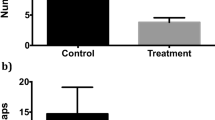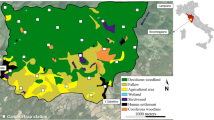Abstract
In the urbanized world, the diurnal cycle of light and darkness has lost its accuracy due to artificial light at night (LAN). Because light is one of the most important zeitgebers for the synchronization of the endogenous clock, this loss of the night has serious implications for health and activity patterns. Although it is a well-known phenomenon that LAN advances the onset of dawn song of passerines, little is known ABOUT whether birds extend their activity into the evening hours and THUS may benefit from exploiting the night light niche. By observing wild urban Blackbirds (Turdus merula) under different LAN intensities, we found birds exposed to high levels of LAN to forage longer in the evening than their conspecifics in the darker areas. This difference was most pronounced during the short days in March, but decreased steeply towards the summer solstice. However, body condition of the Blackbirds did not correlate with the exposure to LAN, indicating that urban birds extending their activity under LAN might not benefit from the prolonged foraging times. Our findings further indicate that male Blackbirds are more sensitive to LAN than females. This study reveals that LAN plays a considerable role in the activity times of urban Blackbirds but, regarding their body condition, other urban factors may be more important than the influence of LAN.
Zusammenfassung
Nutze die Nacht: Amseln (Turdus merula) verlängern ihre Nahrungssuche unter künstlichem Nachlicht
Der tägliche Wechsel zwischen Hell und Dunkel hat in der urbanisierten Welt durch das künstliche Nachtlicht seine Präzision verloren. Da Licht einer der wichtigsten Zeitgeber der inneren Uhr ist, hat dieser Verlust der Nacht weitreichende Auswirkungen auf Gesundheit und Aktivitätsmuster. Der unter künstlichem Licht früher einsetzende Morgengesang von Singvögeln ist ein gut untersuchtes Phänomen, jedoch ist nur wenig darüber bekannt, ob Vögel ihre Aktivität auch in die Abendstunden ausweiten und so von der Nachlicht-Nische profitieren können. Wir beobachteten frei lebende Amseln unter verschiedenen Lichtintensitäten und fanden, dass sie bei hohen nächtlichen Lichtintensitäten ihre Nahrungssuche stärker in die Abendstunden ausweiteten als Artgenossen im dunkleren Gebieten. Dieser Unterschied war während der kurzen Tage im März besonders ausgeprägt, nahm aber zum Sommer hin stark ab. Einen Zusammenhang zwischen der Körperkondition der Vögel und der nächtlichen Lichtintensität konnten wir nicht finden, was darauf hinweist, dass Vögel mit lichtbedingt längeren Aktivitätszeiten nicht von der verlängerten Nahrungssuche profitieren. Darüber hinaus scheinen Amselhähne sensibler als Amselhennen auf künstliches Nachtlicht zu reagieren. Diese Studie deutet darauf hin, dass künstliches Nachtlicht einen bedeutenden Einfluss auf die Aktivitätszeiten von städtischen Amseln hat, aber hinsichtlich der Körperkondition andere urbane Faktoren eine wichtigere Rolle als künstliches Nachtlicht haben.





Similar content being viewed by others
References
Anderies JM, Katti M, Shochat E (2007) Living in the city: resource availability, predation, and bird population dynamics in urban areas. J Theor Biol 247(1):36–49. doi:10.1016/j.jtbi.2007.01.030
Arroyo-Solís A, Castillo JM, Figueroa E, López-Sánchez JL, Slabbekoorn H (2013) Experimental evidence for an impact of anthropogenic noise on dawn chorus timing in urban birds. J Avian Biol 44(3):288–296. doi:10.1111/j.1600-048X.2012.05796.x
Aschoff J (1954) Zeitgeber der tierischen Tagesperiodik. Naturwissenschaften 41(3):49–56. doi:10.1007/BF00634164
Batten LA (1978) Seasonal distribution of recoveries and causes of blackbird mortality. Bird Study 25(1):23–32
Bergen F, Abs M (1997) Verhaltensökologische Studie zur Gesangsaktivität von Blaumeise (Parus caeruleus), Kohlmeise (Parus major) und Buchfink (Fringilla coelebs) in einer Großstadt. J Ornithol 138(4):451–467. doi:10.1007/bf01651380
Bradshaw WE, Holzapfel CM (2007) Evolution of animal photoperiodism. Annu Rev Ecol Evol Syst 38:1–25. doi:10.1146/annurev.ecolsys.37.091305.110115
Burnham KP, Anderson DR (2002) Model selection and multimodel interference: a practical information-theoretic approach, 2nd edn. Springer, New York
Byrkjedal I, Lislevand T, Vogler S (2012) Do passerine birds utilise artificial light to prolong their diurnal activity during winter at northern latitudes? Ornis Norveg 35:37–42
Cinzano P, Falchi F, Elvidge CD (2001) The first World Atlas of the artificial night sky brightness. Mon Not R Astron Soc 328(3):689–707. doi:10.1046/j.1365-8711.2001.04882.x
Cuthill IC, Macdonald WA (1990) Experimental manipulation of the dawn and dusk chorus in the blackbird Turdus merula. Behav Ecol Sociobiol 26(3):209–216
Davies TW, Bennie J, Inger R, Gaston KJ (2013) Artificial light alters natural regimes of night-time sky brightness. Sci Rep 3. doi:10.1038/srep01722
Dawson A, King VM, Bentley GE, Ball GF (2001) Photoperiodic control of seasonality in birds. J Biol Rhythms 16(4):365–380. doi:10.1177/074873001129002079
Dominoni D, Quetting M, Partecke J (2013a) Artificial light at night advances avian reproductive physiology. Proc R Soc Lond B 280 (1756):20123017. doi:10.1098/rspb.2012.3017
Dominoni DM, Helm B, Lehmann M, Dowse HB, Partecke J (2013b) Clocks for the city: circadian differences between forest and city songbirds. Proc R Soc Lond B 280 (1763):20130593. doi:10.1098/rspb.2013.0593
Dominoni DM, Carmona-Wagner EO, Hofmann M, Kranstauber B, Partecke J (2014) Individual-based measurements of light intensity provide new insights into the effects of artificial light at night on daily rhythms of urban-dwelling songbirds. J Anim Ecol 83(3):681–692. doi:10.1111/1365-2656.12150
Dwyer RG, Bearhop S, Campbell HA, Bryant DM (2012) Shedding light on light: benefits of anthropogenic illumination to a nocturnally foraging shorebird. J Anim Ecol 82(2):478–485. doi:10.1111/1365-2656.12012
Frank KD (1988) Impact of outdoor lighting on moths: an assessment. J Lepidopterists Soc 42(2):63–93
Freed LA (1981) Loss of mass in breeding wrens-stress or adaptation. Ecology 62(5):1179–1186. doi:10.2307/1937282
Fuller RA, Warren PH, Gaston KJ (2007) Daytime noise predicts nocturnal singing in urban robins. Biol Lett 3(4):368–370. doi:10.1098/rsbl.2007.0134
Garber SD (1978) Opportunistic feeding behavior of Anolis cristatellus (Iguanidae: Reptilia) in Puerto Rico. Trans Kans Acad Sci 81:79–80
Glutz von Blotzheim U, Bauer KM (1988) Handbuch der Vögel Mitteleuropas. Aula, Wiesbaden
Hoffmann K (1959) Über den Tagesrhythmus der Singvögel im arktischen Sommer. J Ornithol 100(1):84–89. doi:10.1007/bf01671316
Hothorn T, Bretz F, Westfall P (2008) Simultaneous inference in general parametric models. Biom J 50(3):346–363
Hötker H (1999) What determines the time-activity budgets of Avocets (Recurvirostra avosetta)? J Ornithol 140(1):57–71. doi:10.1007/bf02462089
Kempenaers B, Borgström P, Loes P, Schlicht E, Valcu M (2010) Artificial night lighting affects dawn song, extra-pair siring success, and lay date in songbirds. Curr Biol 20:1735–1739. doi:10.1016/j.cub.2010.08.028
Kuechly HU, Kyba CCM, Ruhtz T, Lindemann C, Wolter C, Fischer J, Hölker F (2012) Aerial survey and spatial analysis of sources of light pollution in Berlin, Germany. Remote Sens Environ 126:39–50
Kumar V, Gwinner E, Van’t Hof TJ (2000) Circadian rhythms of melatonin in European starlings exposed to different lighting conditions: relationship with locomotor and feeding rhythms. J Comp Physiol A 186(2):205–215. doi:10.1007/s003590050020
Kyba CCM, Ruhtz T, Fischer J, Hölker F (2011) Cloud coverage acts as an amplifier for ecological light pollution in urban ecosystems. PLoS ONE 6(3):e17307. doi:10.1371/journal.pone.0017307
Longcore T, Rich C (2004) Ecological light pollution. Front Ecol Environ 2(4):191–198. doi:10.1890/1540-9295(2004)002[0191:ELP]2.0.CO;2
Luniak M, Mulsow R, Walasz K Urbanization of the European Blackbird - expansion and adaptations of urban population. In: Luniak M (ed) Urban ecological studies in Central and Eastern Europe; international symposium, Warsaw, Poland, 1990. Polish Academy of Sciences, Warsaw, pp 187–198
Luniak M, Mulsow R (1988) Ecological parameters in urbanization of the European Blackbird. Acta Congr Int Ornithol 19:1787–1793
Mace R (1989) A comparison of great tits (Parus major) use of time in different daylengths at 3 European sites. J Anim Ecol 58(1):143–151
Macleod R, Barnett P, Clark JA, Cresswell W (2005) Body mass change strategies in blackbirds Turdus merula: the starvation–predation risk trade-off. J Anim Ecol 74(2):292–302. doi:10.1111/j.1365-2656.2005.00923.x
Marzluff JM (2001) Worldwide urbanization and its effect on birds. In: Marzluff JM, Bowman R, Donnelly R (eds) Avian Ecology and Conservation in an Urbanizing World. Kluwer, Norwell, pp 19–47
Miller MW (2006) Apparent effects of light pollution on singing behavior of American robins. Condor 108(1):130–139
Murphy MT, Sexton K, Dolan AC, Redmond LJ (2008) Dawn song of the eastern kingbird: an honest signal of male quality? Anim Behav 75(3):1075–1084. doi:10.1016/j.anbehav.2007.08.020
Navara KJ, Nelson RJ (2007) The dark side of light at night: physiological, epidemiological, and ecological consequences. J Pineal Res 43(3):215–224. doi:10.1111/j.1600-079X.2007.00473.x
Nordt A, Klenke R (2013) Sleepless in town–drivers of the temporal shift in dawn song in urban European blackbirds. PLoS ONE 8(8):e71476. doi:10.1371/journal.pone.0071476
Ockendon N, Davis S, Toms M, Mukherjee S (2009) Eye size and the time of arrival of birds at garden feeding stations in winter. J Ornithol 150(4):903–908. doi:10.1007/s10336-009-0412-4
Partecke J, Gwinner E (2007) Increased sedentariness in European blackbirds following urbanization: a consequence of local adaptation? Ecology 88(4):882–890. doi:10.1890/06-1105
Partecke J, Van’t Hof TJ, Gwinner E (2005) Underlying physiological control of reproduction in urban and forest-dwelling European blackbirds Turdus merula. J Avian Biol 36(4):295–305. doi:10.1111/j.0908-8857.2005.03344.x
Poesel A, Kunc HP, Foerster K, Johnsen A, Kempenaers B (2006) Early birds are sexy: male age, dawn song and extrapair paternity in blue tits, Cyanistes (formerly Parus) caeruleus. Anim Behav 72:531–538. doi:10.1016/j.anbehav.2005.10.022
R Development Core Team (2013) R: a language and environment for statistical computing. R Foundation for Statistical Computing, Vienna
Schulte-Hostedde AI, Zinner B, Millar JS, Hickling GJ (2005) Restitution of mass-size residuals: validating body condition indices. Ecology 86(1):155–163. doi:10.1890/04-0232
Schwartz A, Henderson RW (1991) Amphibians and reptiles of the West Indies: descriptions, distributions, and natural history. University of Florida Press, Gainsville
Shochat E (2004) Credit or debit? Resource input changes population dynamics of city-slicker birds. Oikos 106(3):622–626
Stearns SC (1976) Life-history tactics: a review of the ideas. Q Rev Biol 51:3–47
Stephan B (1999) Die Amsel. Die Neue Brehm-Bücherei Bd. 95. 2 edn. Westarp Wissenschaften, Hohenswarsleben
Strohbach MW, Haase D, Kabisch N (2009) Birds and the city: urban biodiversity, land use, and socioeconomics. Ecol Soc 14(2):31
Thomas RJ, Széskely T, Cuthill IC, Harper DGC, Newson SE, Frayling TD, Wallis PD (2002) Eye size in birds and the timing of song at dawn. Proc R Soc Lond B 269(1493):831–837. doi:10.1098/rspb.2001.1941
Wood SN (2004) Stable and efficient multiple smoothing parameter estimation for generalized additive models. J Am Stat Assoc 99:673–686
Zuur AF, Ieno EN, Walker NJ, Saveliev AA, Smith GM (2009) Mixed effects models and extensions in ecology with R. Springer, New York
Acknowledgments
We thank Diana Höhlig, Stephanie Ibsen, and Pia Schmitz for obtaining Blackbird observations, and Simon Dietzel, Sarah Effertz, Daniela Dunger, Diana Höhlig, Terezia Lucenicova, and Rebecca Thier-Lange, for their help in mistnetting. Without the support of these field assistants this work would not have been possible. Stephanie Ibsen and two anonymous reviewers provided useful comments on an earlier draft and considerably improved the manuscript. The project was funded by the Federal Ministry of Education and Research (BMBF, http://www.bmbf.de/en/index.php, FKZ: 033L038E), additional financial support was provided by Helmholtz Impulse and Networking Fund through Helmholtz Interdisciplinary Graduate School for Environmental Research (http://www.higrade.ufz.de). Bird handling and observations were carried out under the permission of the relevant German agencies.
Conflict of interest
The authors declare that they have no conflict of interest.
Author information
Authors and Affiliations
Corresponding author
Additional information
Communicated by F. Bairlein.
Electronic supplementary material
Below is the link to the electronic supplementary material.
Rights and permissions
About this article
Cite this article
Russ, A., Rüger, A. & Klenke, R. Seize the night: European Blackbirds (Turdus merula) extend their foraging activity under artificial illumination. J Ornithol 156, 123–131 (2015). https://doi.org/10.1007/s10336-014-1105-1
Received:
Revised:
Accepted:
Published:
Issue Date:
DOI: https://doi.org/10.1007/s10336-014-1105-1




